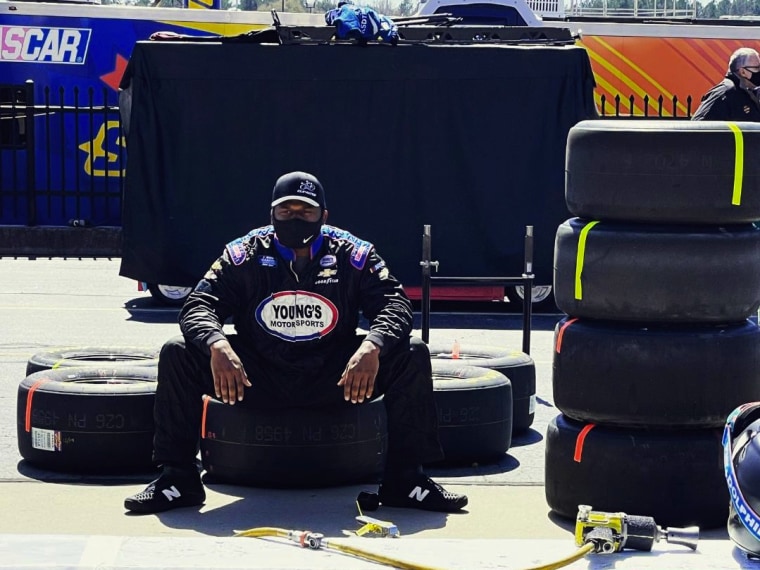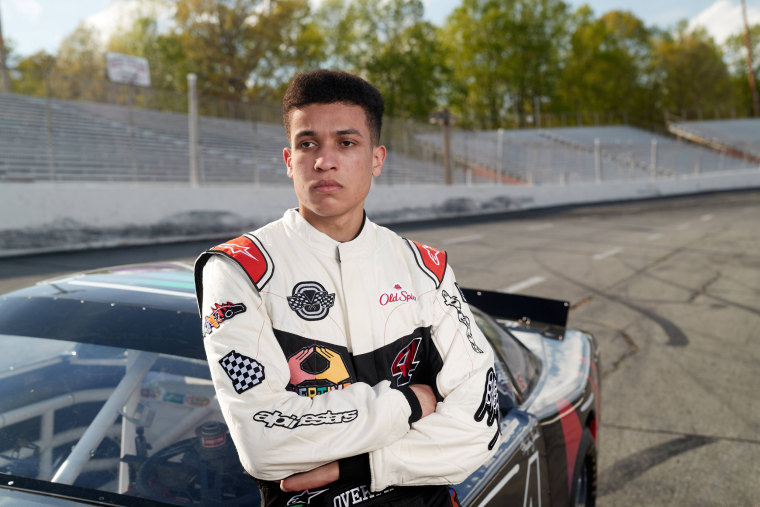A year ago, Hayden Swank sold his beloved car so he could drive faster cars.
The 19-year-old was running out of money to support his fledgling career in race car driving that he hopes will one day land him a spot in NASCAR. So he did the unfathomable for a teenager and unloaded his 2004 Mercury Grand Marquis.
From the Atlanta-area town of Woodstock, Swank has been considered by many a wunderkind of race car driving. So far, he has racked up more than 20 wins since he first eased behind a steering wheel of a quarter midget car when he was 7 years old.
Fulfilling his promise, though, was precarious until he and his team gained sponsorships from Overtime, the sports brand and basketball league, and the men's grooming brand Old Spice.
The relief Swank felt was palpable, played out during an enlightening eight-part Overtime series called Race that chronicles his challenges and triumphs, from financial concerns to car malfunctions, to dealing with volatile fans and opposition, to his parents’ support, to balancing college and racing.
“This sport has a history that is not diverse,” said Swank, who is studying business at the University of Georgia. “The sport has a lot of work to do. I have accepted that. My job is not to win people over, just to win races.”
Not that anything has come easy. The teenager said he has heard his fair share of ugly remarks from drivers and teams, as well as fans. In the Overtime series, a crew member urged him not to reveal his face — and racial identity — before a race: “Don’t not take off your helmet, no matter what.”
Poised and thoughtful, Swank said participating in a sport that has historically had very few Black drivers at the highest level of the profession — Bubba Wallace follows Wendell Scott, who broke NASCAR's race barrier in the 1960s — tests his patience, but grows his resolve.
“I cope,” he said. “When I show up, I’m not only the only mixed or Black person racing, but I’m the only minority in the whole place of maybe 2,000 people. So, sure, I feel like an outsider, like I don’t belong. There’s added pressure.
“Some people claim I’m there because I’m a token, that we paid our way. That’s not close to true. For the most part, I think they respect me. But there are a few drivers I won’t be friends with. And there are certain tracks that are not fans of mine. But I accept it.”
In 2004, NASCAR instituted the NASCAR Diversity Pit Crew Internship Program, which has produced at least 55 Black graduates working in NASCAR, including Brehanna Daniels. The former basketball player at the historically Black Norfolk State University made history in 2018 as the first Black woman to work on a pit crew in NASCAR’s top series.
Daniels excelled and in 2019 she became the first African American woman to serve on a pit crew at the Daytona 500.
Raynard Revels II, also a Norfolk State graduate, took advantage of the Drive for Diversity Program in 2019 and has used the last two years to work as a pit crew member for hire as he seeks to elevate onto a premier team. The former linebacker for the football team who lives in Charlotte had never been to a NASCAR race before entering the program.
Black men who worked or work in pit crews — Dion “Rocko” Williams, Phil Horton, Ernest Holden and Lamar Neal — serve as either mentors or a support system for Revels.
“It’s a predominantly white sport, but I look at it as being on a team,” Revels, 27, said. “And when you’re on a team, you do all you can to win.”

Other HBCUs like Johnson C. Smith University in Charlotte are encouraging students to pursue a career in the sport. And while the efforts have worked out for Davis and others, there are still only three nonwhite drivers: Wallace, who is Black, Kyle Larson, who is Japanese American, and Daniel Suárez, who is Mexican.
Last summer, the world Swank wants to compete in came into full light during the Black Lives Matter demonstrations. Wallace had publicly supported BLM and called for the removal of Confederate flags at races. Soon after, a noose was found hanging in his garage at Talladega Raceway in Alabama — a clear threat that harkens to the days when Black people were openly lynched.
An FBI investigation found that the rope may have looked like a noose, it was actually a garage pull rope. By then, the drivers had lined up behind Wallace on pit road as a show of solidarity.
Mahogany Boss, a Black woman who said she loves NASCAR and used to race cars in low-level competition, said she “definitely experienced racism at the track. There have been moments when I lashed back out, and moments I’ve just shaken it off. . . I have been around many other Black people who have a serious love for the sport. . . But I hope to see more Black race car drivers, male and female.”
Swank watches it all play out, and is bothered by some of what he sees and experiences, but not deterred.
“I was always drawn to NASCAR,” he said. “Growing up, I didn’t have a Bubba Wallace to look up to, anyone who looks like me. Lots of people like the idea of cars going fast, but the lack of diversity turns Black people away from the sport
“There’s a long way to go. Unfortunately, dealing with some stuff is part of the job. I recognize I have to face obstacles a lot of other racers won’t have to face. I won’t let it discourage me.”
Still, the environment before he squeezes into his No. 4 car is not exactly welcoming. “The idea of ‘You don’t belong there’ creeps into your mind a little,” he said. “I feel added pressure to represent for Black people every time I go out.”
The weight on his shoulders, he said, can be taxing. ”I’m a big proponent of helping people and understanding people. But I have had to compartmentalize things. I realize I’m not going to change anyone’s minds out here.”

Wallace’s career changed when he became the driver of the NASCAR team purchased last year by Michael Jordan. The NBA legend and Charlotte Bobcat owner became the first Black principal owner of a racing team on the top level since Wendell Scott owned and drove his car almost 50 years ago.
Swank’s team and the backing of Overtime and Old Spice have bolstered his aspirations, even as he begins his third year of college. Swank started out racing in quarter midget cars and then moved into Bandolero and Legend cars when he was older. He now races in the Late Models division, with an eye on elevating to the ARCA series next. Right now, he if focusing on college until his next race near the end of the summer.
“I have a great team of people around me that supports me,” he said. “It was rough before Overtime and Old Spice came in. But that’s the challenge in racing—funding. You have to have the right partners, some luck and a great group of people around you.”
Those people include his mother, Jennifer, who is Black and works in medical billing. She fears for her son’s safety, but is encouraging. “When they put you in the back, race your way to the front,” she tells Hayden in the series.
His dad, Bob, is white and a high school football coach. He bought his son his first car and “I’ve been driving ever since,” Swank said.
Harvey Holmes, a Black NASCAR fan, said, “It would be great to see more Black drivers. There is money to be made and you don’t have to be a certain type of athlete, just talented. We have to stop putting ourselves in a box, and learn new sports. Jim Brown played Lacrosse.”
Swank is definitely playing outside the box. The question is: Will he eventually compete inside it?
“I feel like an outsider sometimes, like I don’t belong,” he said. “But I’m going to keep going. The path is clear . . . hopefully.”

